"Great music is that which penetrates the ear with facility and leaves
the memory with difficulty. Magical music never leaves the memory."
AUTHOR: Thomas Beecham
great music has patterns of sounds you cannot forget."
COMPOSER
RAVEL

MOTHER GOOSE SUITE
Ma mère l'Oye

MOTHER GOOSE SUITE
Ma mère l'Oye
MOTHER GOOSE SUITE
Ma Mère L'Oye
For Orchestra
(Complete)
(Complete)
Walter Damrosch, Conductor
New York Symphony Orchestra, 1927
.jpg) |
| Jessie Willcox-Smith: Mother Goose, 1914 |
Ma Mère L'Oye - suite (1911)
I. Pavane de la belle au bois dormant - Lent
Pavane of Sleeping Beauty
1:52 II. Petit Poucet - Très modéré
Little Tom Thumb / Hop o' My Thumb
6:42 III. Laideronnette, impératrice des pagodes - Mouvt de marche
Little Ugly Girl, Empress of the Pagodas
10:13 IV. Les entretiens de la belle et de la bête - Mouvt de valse très modéré
Conversation of Beauty and the Beast
14:14 V. Le jardin féerique Lent et grave
The Fairy Garden
Maurice Ravel's Ma Mère L'oye
(Mother Goose), subtitled Five
Pieces for Children ("Cinq Pièces
Enfantines"), first appeared as a
series of miniatures for piano four
hands. Ravel composed the first
piece from the set of duets
in 1908 as a surprise gift for two
young piano students, ages 6 and 7,
Mimi and Jean Godebski (the dedicatees),
the children of his dear friends
(Mother Goose), subtitled Five
Pieces for Children ("Cinq Pièces
Enfantines"), first appeared as a
series of miniatures for piano four
hands. Ravel composed the first
piece from the set of duets
in 1908 as a surprise gift for two
young piano students, ages 6 and 7,
Mimi and Jean Godebski (the dedicatees),
the children of his dear friends
Cipa and Ida Godebski.
(He had dedicated an earlier
(He had dedicated an earlier
work, Sonatine,
to their parents.)
 |
| Sonatine |
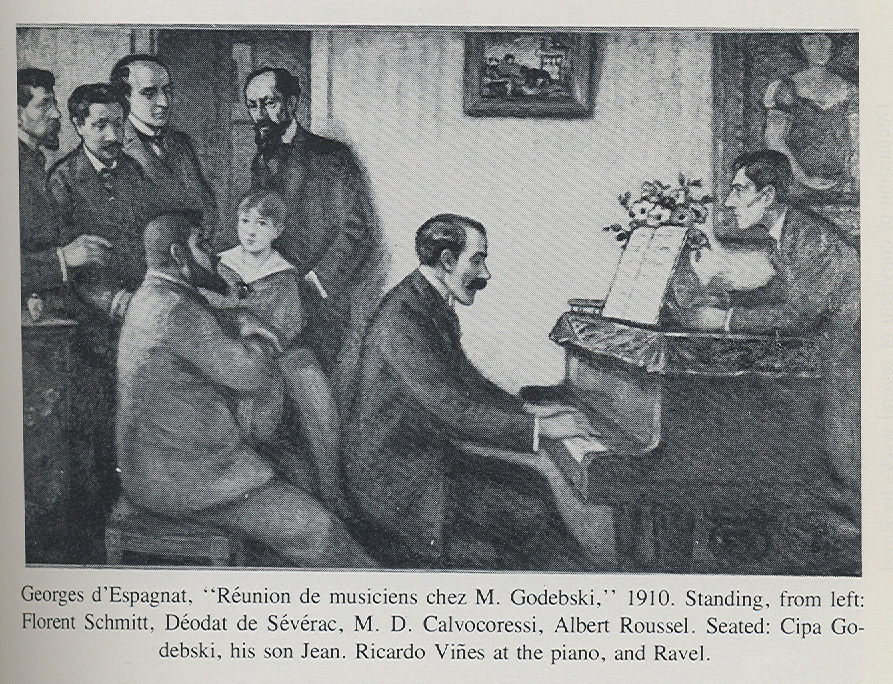 |
| http://qcpages.qc.cuny.edu/hhowe/music784/images/index.html |
 |
| Edouard Vuillard: The Black Cups [a grown-up Mimi Godebska (right) with her famous aunt, Misia Sert (left)] |
Unmarried and childless, but adoring
children and their world of fantasy, Ravel
loved to play with young Mimi and Jean
and often delighted them with his animated
readings of various Mother Goose stories
and drawing upon the fairy-tales of
Charles Perrault.
children and their world of fantasy, Ravel
loved to play with young Mimi and Jean
and often delighted them with his animated
readings of various Mother Goose stories
and drawing upon the fairy-tales of
Charles Perrault.
 |
| Charles Perrault (1628-1703) |
which were as well- known in
his time as they are today.
Using some of these stories as the
programmatic theme for his
composition Ravel sought to write
piano music that not only could be
played by children, but reflected
their world of childhood. Ravel noted:
"The idea of evoking in these pieces the poetry of
childhood naturally led me to simplify my style and
to refine my means of expression."
his time as they are today.
Using some of these stories as the
programmatic theme for his
composition Ravel sought to write
piano music that not only could be
played by children, but reflected
their world of childhood. Ravel noted:
"The idea of evoking in these pieces the poetry of
childhood naturally led me to simplify my style and
to refine my means of expression."
 |
| Drawing of Ravel by Jean Godebski |
The first movement, La Pavane de la
Belle au Bois Dormant, was written in
1908 as Ravel's father was dying
(he passed a month later) while the
other four movements, with the
encouragement of his publisher
Jacques Durand,

were written in April 1910. The
original intention was that the
Godebski children would give the
first performance however the music
proved to be too difficult for them so
the work was performed at a concert,
only a few days after the composition
was completed, on April 20th, by the
11-year old Jeanne Leleu and the
14-year old Geneviève Durony.
Later that same year the work was
transcribed for solo piano by Ravel's
friend Jacques Charlot. In 1911, three
years later, Ravel orchestrated the
work for a full orchestra,






score for orchestra with revisions and annotations, 1911.
(Second page showing missing bassoon line.)
(Second page showing missing bassoon line.)
MOTHER GOOSE SUITE
ORCHESTRATION
Director Giancarlo Guerrero
of the National Symphony shares how
a piano duet evolved into one of the
one of the world's favorite
orchestral works.


 |
| Jacques Rouché, 1910 |
received its premiere at the
Théâtre des Arts in Paris.
MOTHER GOOSE BALLET
Ma Mère L'Oye
David Grandis, Conductor
University of Wisconsin Chamber Orchestra
1- Prélude
2-Danse du Rouet -- 3'20''
3-Pavane de la Belle au Bois Dormant -- 6'40''
4-Les Entretiens de la Belle et de la Bête -- 9'13''
5-Petit Poucet -- 14'04''
6-Laideronnette, Impératrice des Pagodes -- 19'04''
7-Le Jardin Féerique -- 23'28''
For the ballet he decided to frame the
narrative with the story of Sleeping
Beauty with which the ballet begins
and ends. The remaining stories are
cast as the beauty's dreams. He
re-ordered the movements and added
a Prelude and the Danse du Rouet et
Scène (Spining Wheel Dance and Scene)
along with linking intermezzos.


There are seven numbers,
eleven if the interludes are included.
They are:
I. Prélude
PreludeTrès Lent
II. Premier Tableau
Danse du Rouet et Scène
Spinning Wheel Dance and Scene
III. Deuxième Tableau
Pavane de la Belle au Bois Dormant
IV. Interlude
V. Troisième Tableau
Les Entretiens de la Belle et de la Bête
VI. Interlude
VII. Quatrième Tableau
Petit Poucet
VIII. Interlude
IX. Cinquième Tableau
Laideronnette, Impératrice des Pagodes
X. Interlude
XI. Sixième Tableau
Le Jardin Féerique
for string ensemble as well.
MOTHER GOOSE SUITE
Ma Mère L'Oye
(For Piano, Violin,
Viola, Cello, and Bass)
Roland Kato, Arranger
Sewanee Summer Music Festival Faculty
Ma Mère L'Oye
(For Piano, Violin,
Viola, Cello, and Bass)
Roland Kato, Arranger
Sewanee Summer Music Festival Faculty
I. Pavane de la Belle au Bois Dormant
II. Petit Poucet
III. Laideronnette, Imperatrice des Pagodes
IV. Les Entretienes de la Belle et la Bete
Le Jardin Feerique
 |
Louis-Léopold Boilly: And the ogre ate him...
(illustration for fairy tale), 1824
|
1. Courtly Dance of Sleeping Beauty
(Pavane de la Belle au Bois Dormant)
2. Little Tom Thumb
(Petit Poucet)
3. Little Ugly Girl, Empress of the Pagodas
(Laideronnette, Impératrice des Pagodes)
4. Conversation of Beauty and the Beast
(Les Entretiens de la Belle et de la Bête)
5. The Fairy Garden
(Le Jardin Féerique)
1. Pavane of the Sleeping Beauty
Scott Brothers Duo, Pianos
Scott Brothers Duo, Pianos
 |
| John Dixon Batten: The Princess pricks her Finger |
Ma Mère L'Oye
For Orchestra
1. Pavane of the Sleeping Princess
Yu Lu, Conductor
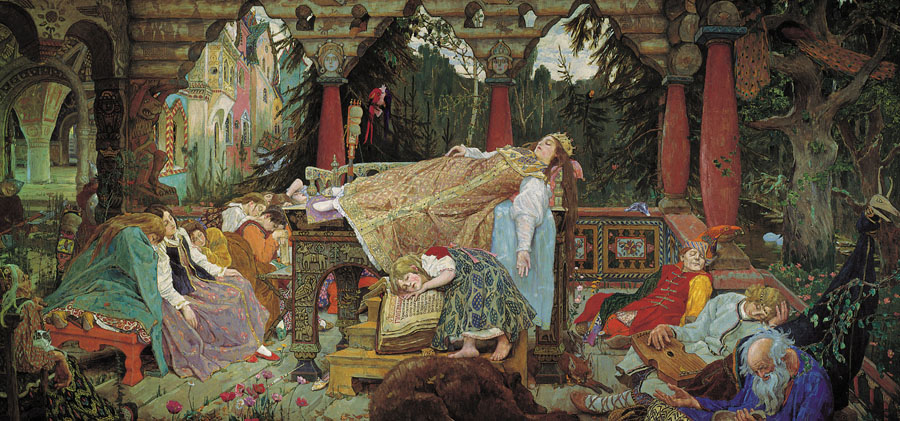
FIRST MOVEMENT
Pavane of the Sleeping Beauty
(Pavane de la Belle au Bois Dormant)
Pavane of the Sleeping Beauty
(Pavane de la Belle au Bois Dormant)
The suite begins and ends with the
Sleeping Beauty story (from the
collection of stories by Charles
Perrault) which he published in 1697
entitled Histoires ou contes du temps
passé avec des moralitez (Tales and
Stories of the Past with Morals) with
the subtitle Les Contes de ma Mère
20 measures long), the Aeolean mode
is heard in the main theme played in the
orchestral version by the flute, with a
counter melody played by muted horn
and violas. There is a great deal of
grace and beauty concentrated into this
short segment suggesting the quiet
atmosphere of Sleeping Beauty's
perpetual slumber.
It is the simplification
 |
| Edmund Dulac: Sleeping Beauty |
of style and expression which makes this
movement so delicate and magical.
PAVANE OF THE SLEEPING BEAUTY
LESSON PLAN
PAVANE OF THE SLEEPING BEAUTY
LESSON PLAN
| Arthur Wardle: A Fairy Tale |
Ma Mère L'Oye
Piano Duet
Piano Duet

MOTHER GOOSE SUITE
Ma Mère L'Oye
For Orchestra
2. Hop-O-My-Thumb
Yu Lu, Conductor
 |
| Kellie Scheider: Tom Thumb: Lost in the Woods |
Tom Thumb or Hop-o' My Thumb
(Petit Poucet)
(Petit Poucet)
In the preface to this movement, Ravel
includes the following excerpt from the
Perrault fairy tale:
"He believed that he would easily find
his way by means of his breadcrumbs,
which he had scattered as he passed
along; but to his surprise he could
not find a single crumb, for the
birds had come and eaten them up."

In the story Tom's uncertain wanderings,
his searching through the forest trying to
find his way home; his state of bewilder-
ment and unease, is created by a plaintive
and meandering melody (first played by a
solo oboe against muted violins in the
orchestral arrangement) over parallel thirds.
A constantly shifting meter, moving between
2/4, 3/4, 4/4 and 5/4, in the accompaniment
also helps create a feeling of Tom's uncertainty.
The middle section depicts the chirping and
twittering of the birds whilst eating the crumbs.

Trills and obligatory intervals of falling minor
thirds (a cuckoo) emulate the bird sounds.
These sounds are clearly audible because
they are played at the top of the piano's range.
In the orchestrated version, Ravel recreates
the sounds of the ravenous birds through a
masterful combination of strings (using
special techniques such as glissand
string harmonics and playing over the
fingerboard) and woodwinds. The
opening theme returns but only to
lose its way again at the end.
HOP O' MY THUMB
LESSON PLANS
his way by means of his breadcrumbs,
which he had scattered as he passed
along; but to his surprise he could
not find a single crumb, for the
birds had come and eaten them up."

In the story Tom's uncertain wanderings,
his searching through the forest trying to
find his way home; his state of bewilder-
ment and unease, is created by a plaintive
and meandering melody (first played by a
solo oboe against muted violins in the
orchestral arrangement) over parallel thirds.
A constantly shifting meter, moving between
2/4, 3/4, 4/4 and 5/4, in the accompaniment
also helps create a feeling of Tom's uncertainty.
 |
| Margaret Evans Price: "Don't be afraid boys." 1921 |
twittering of the birds whilst eating the crumbs.

Trills and obligatory intervals of falling minor
thirds (a cuckoo) emulate the bird sounds.
These sounds are clearly audible because
they are played at the top of the piano's range.
In the orchestrated version, Ravel recreates
the sounds of the ravenous birds through a
masterful combination of strings (using
special techniques such as glissand
string harmonics and playing over the
fingerboard) and woodwinds. The
opening theme returns but only to
lose its way again at the end.
HOP O' MY THUMB
LESSON PLANS
 |
| Adrienne Ségur: Hop o' My Thumb |
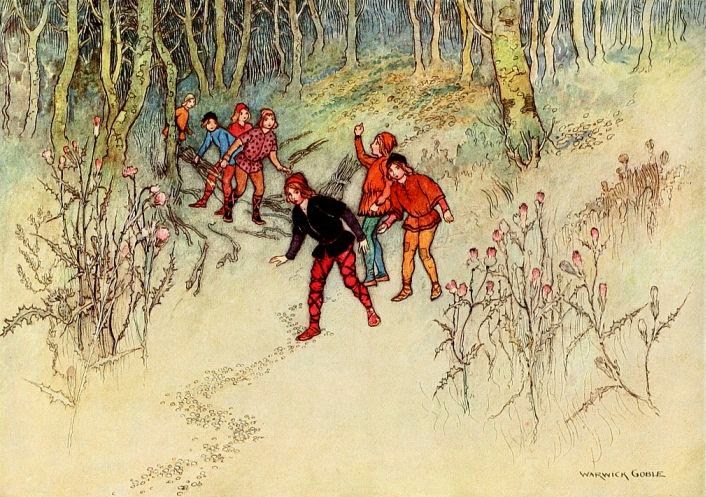 |
| Warwick Goble: Hop-o'-my-thumb knew well enough how to lead them safe home... |
MOTHER GOOSE SUITE
Ma Mère L'Oye
Piano Duet
Ma Mère L'Oye
Piano Duet
3. Laideronnette, Empress of the Pagodas
(Little Ugly One, Empress of the Pagodas)
Scott Brothers Duo, Pianos
Scott Brothers Duo, Pianos
 |
| Edmund Dulac's Fairy-Book Laideronnette kissed and embraced the good Fairy Protectress. |
MOTHER GOOSE SUITE
Ma Mère L'Oye
For Orchestra
3. Laideronnette, Empress of the Pagodas
Pierre Boulez, Conductor
Mahler Chamber Orchestra
(Laideronnette, Impératrice des Pagodes)
 |
| Marie-Catherine d'Aulnoy (1650-1705) |
story, "Le Serpentin Vert" (The Green Serpent).
She was the person thought to have coined
the term Contees de Fée (fairy tale).

Ravel quotes the following excerpt from
this fairy tale in his the score:
"She undressed and entered the bath.
Immediately the pagodas, male and female,
began to sing and to play on various
instruments. Some had theorbos, or lutes,
She was the person thought to have coined
the term Contees de Fée (fairy tale).

Ravel quotes the following excerpt from
this fairy tale in his the score:
"She undressed and entered the bath.
Immediately the pagodas, male and female,
began to sing and to play on various
instruments. Some had theorbos, or lutes,
made of walnut shells,
others viols
made of almond shells. For they were
obliged to use instruments proportionate
to their shapes and sizes."
In the story Laideronnette was a beautiful
obliged to use instruments proportionate
to their shapes and sizes."
In the story Laideronnette was a beautiful
Chinese princess who had been cursed by
a wicked witch who then horribly transformed
her to become ugly. While walking in the
forest she came upon an equally ugly
green serpent who told her that he also
was formerly a handsome prince and
that the same witch had cursed him.
They wander for years together as their only
companions until one day they end up in
the Island of the Pagodas where they
encounter living pagodas made of
porcelain, crystal, diamonds, and emeralds.
They take Laideronnette as their queen.
Eventually, she marries the serpent and, the
spell broken, they are both transformed into
a beautiful princess and handsome prince
and live happily ever after.
sonorities that recall gamelan ensembles.
a wicked witch who then horribly transformed
her to become ugly. While walking in the
forest she came upon an equally ugly
green serpent who told her that he also
was formerly a handsome prince and
that the same witch had cursed him.
 |
| Serpent |
companions until one day they end up in
the Island of the Pagodas where they
encounter living pagodas made of
porcelain, crystal, diamonds, and emeralds.
They take Laideronnette as their queen.
Eventually, she marries the serpent and, the
spell broken, they are both transformed into
a beautiful princess and handsome prince
and live happily ever after.
 |
| Adrienne Segur |
Ravel's fascination with Asian music is
reflected in the use of pentatonic scales andsonorities that recall gamelan ensembles.
 |
| http://alek.zipzap.ch/gamelan/bosastra/game_eng.htm |
GAMELAN
MUSIC OF INDONESIA
 |
| http://hubpages.com/hub/Play-Pentatonic-Scales-on-the-Piano |
The pentatonic oriental-ish melody heard
first on the piccolo in the orchestra
arrangement was originally written entirely
for the black keys of the piano.
An example of the mastery of Ravel's
orchestrational skills are on display in the
orchestra version of this movement when he
shows the difference in timbre between an
instrument being made of walnut vs. almond
shells by scoring the flute in its lower register
as it trades passages with the English horn
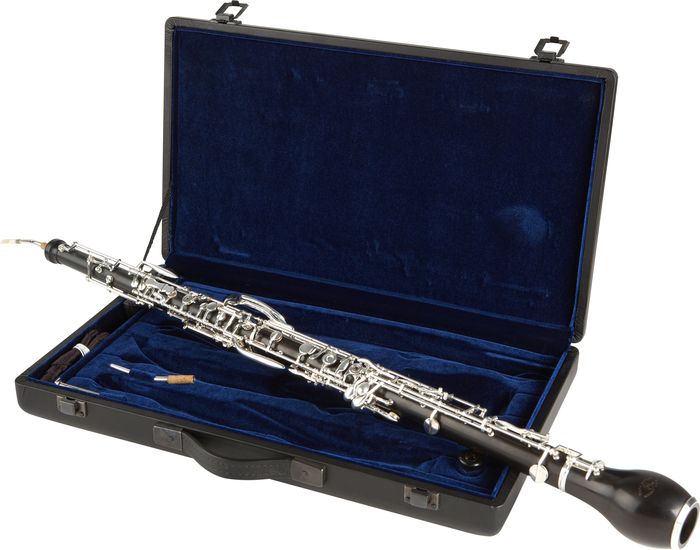 |
| English Horn |
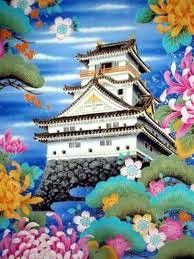 |
| http://www.free-scores.com/ download-sheet-music.php?pdf=41350 |
LAIDERONNETTE,
EMPRESS OF THE PAGODAS
LESSON PLANS
EMPRESS OF THE PAGODAS
LESSON PLANS
MOTHER GOOSE SUITE
Ma Mère L'Oye
Piano Duet
Piano Duet
4. Conversation of Beauty and the Beast
Scott Brothers Duo, Pianos
Scott Brothers Duo, Pianos
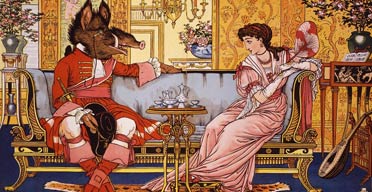 |
| Walter Crane: Beauty and the Beast, 1874 |
MOTHER GOOSE SUITE
Ma Mère L'Oye
For Orchestra
4. Conversation of Beauty and the Beast
Bernard Haitink, Conductor
Concertgebouw Orchestra, Amsterdam
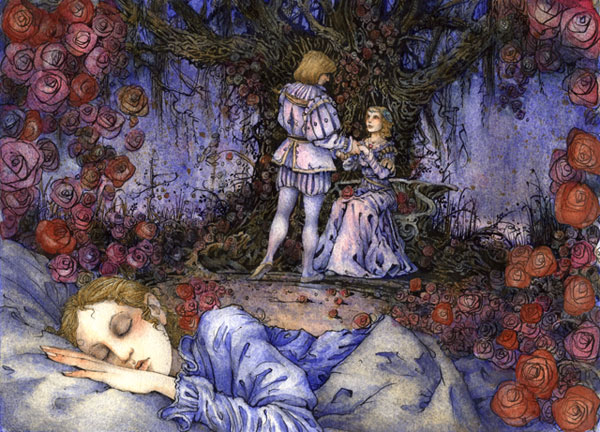 |
| Mercer Meyer: Beauty and the Beast |
Conversation of Beauty and the Beast
(Les Entretiens de la Belle et de la Bête)
This movement comes from a story by
Jeanne-Marie Le Prince de Beaumont.
This movement comes from a story by
Jeanne-Marie Le Prince de Beaumont.
 |
| Jeanne-Marie Le Prince de Beaumont (1711-1780) |
Here, the Beauty takes note of the Beast's
kind heart that makes him, somehow, less
unattractive. The Beast pleads with the
Beauty to marry him. At first the Beauty
declines, but finally agrees.
 |
| Margaret Evans Price |
Ravel's score includes a
dialogue from the story:
"When I think how, kind-hearted you
are, you don’t seem so ugly."
"Yes, it is true, I have a kind
heart. Still, I am a beast."
"Many men are more beastly than you."
"If I were witty I would think up a fine compliment
by way of thanks, but I am only a beast."
"Beauty, will you be my wife?"
"No, Beast!"
"I die happy because I have had
the pleasure of seeing you again."
"No, my dear Beast, you shall not die.
You shall live to be my husband!"
 |
| Walter Crane |
The Beast vanished and at
her feet she saw a prince
as beautiful as the God of Love.
 |
Eleanor Vere Boyle:
Beauty and the Beast
|
The prince thanked her for breaking
the spell laid upon him.
 |
| Margaret Evans Price |
Ravel acknowledged Erik Satie
as the "grand-papa" of this
movement which resembles
Satie's Gymnopédie.
By Erik Satie
https://www.youtube.com/watch?v=S-Xm7s9eGxU
The first two sections of music
depict the Beauty with a elegant
lilting waltz in the orchestra
version first played by the solo
clarinet and as the movement
progresses she moves to solo
flute then solo oboe. The Beast
is is perfectly described and easily
recognized as ponderous and
awkward by the deep grotesque
notes played at the bass of the
piano or in the orchestra version
by the contrabassoon.
When Beauty declares her love,
version first played by the solo
clarinet and as the movement
progresses she moves to solo
flute then solo oboe. The Beast
 |
| Anne Anderson: Beauty and the Beast |
recognized as ponderous and
awkward by the deep grotesque
notes played at the bass of the
piano or in the orchestra version
by the contrabassoon.
 |
| Contrabassoon |
their melodies are combined. A
magical glissando (played in the
orchestra arrangement by the harp
and ending with a cymbal crash
symbolizing the breaking of the spell)
signals that the beast has been
transformed to his former state, a
handsome prince (the beauty is now
a solo violin and the beast a solo
cello in the orchestra version).
BEAUTY AND THE BEAST
LESSON PLANS
magical glissando (played in the
orchestra arrangement by the harp
and ending with a cymbal crash
symbolizing the breaking of the spell)
signals that the beast has been
transformed to his former state, a
handsome prince (the beauty is now
a solo violin and the beast a solo
cello in the orchestra version).
BEAUTY AND THE BEAST
LESSON PLANS
 |
| Toshiaki Kato: Beauty and the Beast |
MOTHER GOOSE SUITE
Ma Mère L'Oye
Piano Duet
5. The Fairy Garden
Scott Brothers Duo, Pianos
 |
| Kellie Schneider: Enchanted Garden |
MOTHER GOOSE SUITE
Ma Mère L'Oye
For Orchestra
5. The Fairy Garden
(With Monet Paintings)
Ernest Ansermet, Conductor
L'Orchestre de la Suisse Romande
 |
| Edmond Dulac |
MOTHER GOOSE SUITE
Ma Mère L'Oye
For Orchestra
5. The Fairy Garden
Leonard Slatkin, Conductor
Detroit Symphony Orchestra
 |
| Richard Dadd: The Fairy Feller's Master-Stroke |
FIFTH MOVEMENT
The Fairy Garden
(Le Jardin Féerique)
This is a tale of Ravel's own imagination.
Returning to the mood of the first move-
ment, it brings the work to conclusion.
It depicts the awakening of the Sleeping
Beauty, performed by the celesta

in the orchestra version, as she slowly opens
her eyes amid a wonderful crescendo
after a kiss from Prince Charming.


As they process through the Fairy
Godmother's garden, a simple, yet
hauntingly affecting melody is introduced
(played by the strings in the orchestra version)
and then the movement climaxes with fanfares
and wedding bells as as the Good Fairy
gives the couple her blessings
Returning to the mood of the first move-
ment, it brings the work to conclusion.
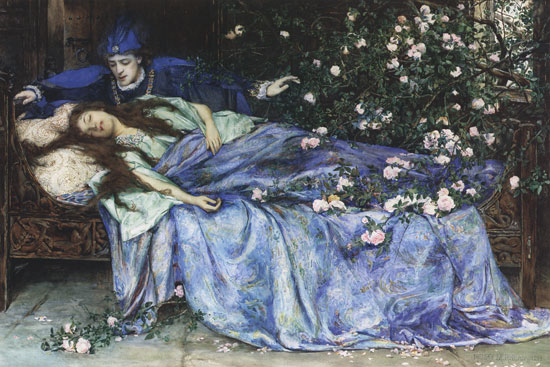 |
| Henry Meynell Rheam: Sleeping Beauty |
Beauty, performed by the celesta

in the orchestra version, as she slowly opens
her eyes amid a wonderful crescendo
after a kiss from Prince Charming.


As they process through the Fairy
Godmother's garden, a simple, yet
hauntingly affecting melody is introduced
(played by the strings in the orchestra version)
and then the movement climaxes with fanfares
and wedding bells as as the Good Fairy
gives the couple her blessings
 |

MOTHER GOOSE SUITE
LISTENING GUIDE

 |
| Adrienne Segur: Sleeping Beauty |
LINKS
 |
| Vera Smirnova: Sleeping Beauty |
https://www.learntogether.org.uk/Resources/Documents/Mother%
20Goose%20Suite%20Resource%20Pack%20M%20Ravel.doc
http://www.favorite-classical-composers.com/mother-goose-suite.html
http://www.fwsymphony.org/education/materials/13-14_picture_the_music.pdf
20Goose%20Suite%20Resource%20Pack%20M%20Ravel.doc
http://www.favorite-classical-composers.com/mother-goose-suite.html
http://www.fwsymphony.org/education/materials/13-14_picture_the_music.pdf









.jpg)
.jpg)

.jpg)

.jpg)
0002.jpg)





.jpg)
0004.jpg)

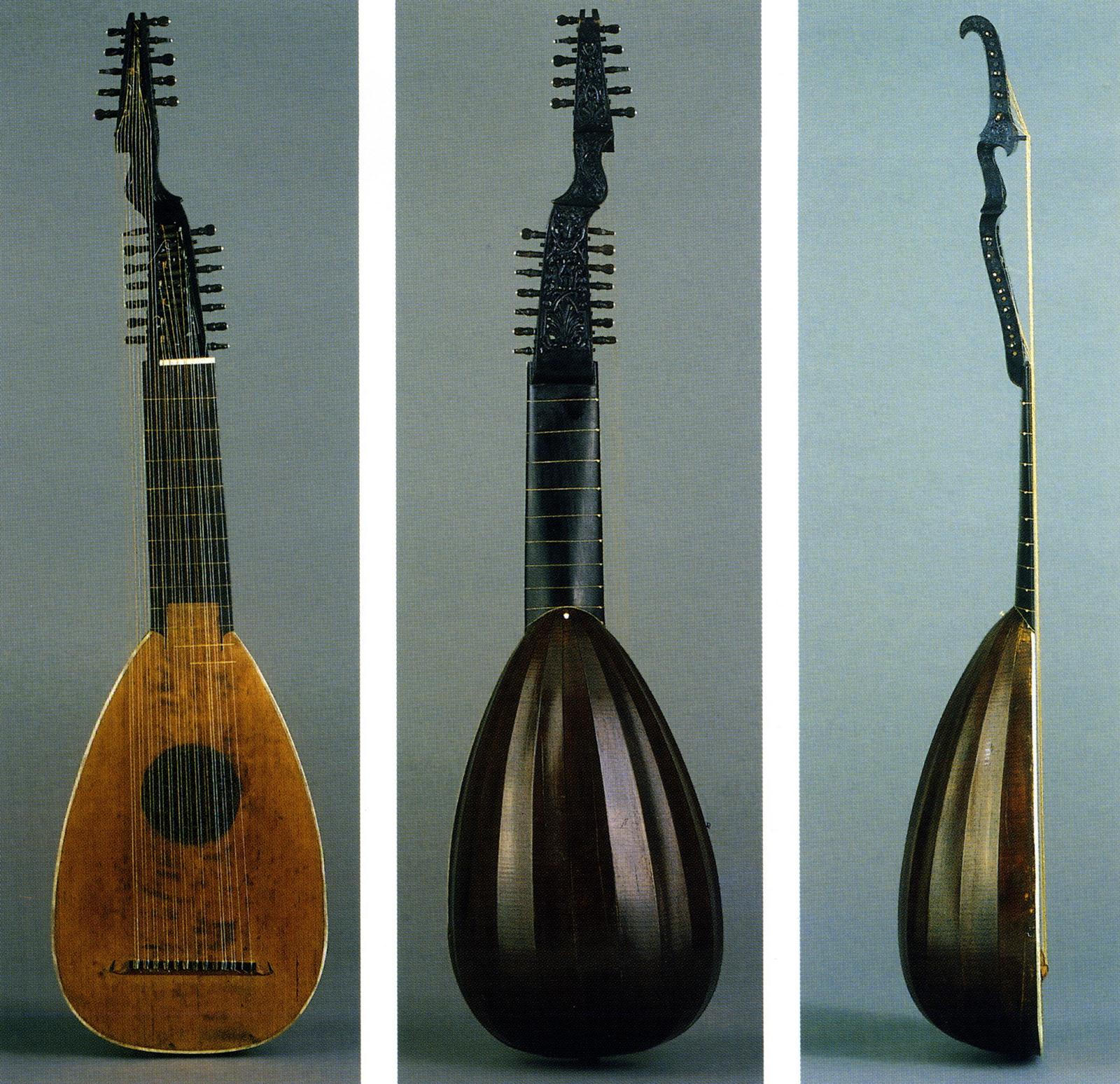












.jpg)
0002.jpg)







.jpg)



0001.jpg)
0002.jpg)
0004.jpg)